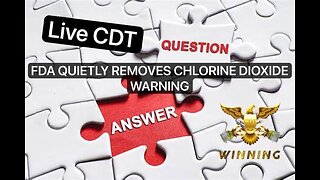Premium Only Content

CDT Live Audio Chat: The Forced of Evolution Humanity - 5th Gen Warfare: Detox with Chlorine Dioxide
Join Chlorine Dioxide Testimonies on Telegram to ask your questions live:
https://t.me/ChlorineDioxideTestimonies
Donate to Chlorine Dioxide Testimonies ⬇️
https://www.buymeacoffee.com/ChlorineDioxide
Join CDT Live Audio Chat for free:
https://t.me/ChlorineDioxideTestimonies?videochat
Learn about Chlorine Dioxide and other God given resources to detox your temple.
Join Chlorine Dioxide Testimonies on Telegram to ask your questions live or just listen in on Rumble.
View Original source for more details:
https://dfreality.substack.com/p/the-forced-evolution-of-humanity
Description: The description will be developed by the members of Chlorine Dioxide Testimonies on Telegram.
The Forced Evolution of Humanity: FIRST-HAND EVIDENCE of nanotechnology within the blood of the injected and infected. The worst crime in the history of mankind.
Fifth-generation warfare is conducted primarily through non-kinetic military action, such as social engineering, misinformation, and cyberattacks, along with emerging technologies such as artificial intelligence and fully autonomous systems. Fifth generation warfare has been described by Daniel Abbot as a war of "information and perception".
Graphene is carbon-based nanomaterial which was first discovered in 2004 by the working group of Andre Geim. Due to its unique properties and diverse properties such as transparency (depending on number of layers), thermal property, electrical conductivity and mechanical strength make it a versatile material for various fields. These include for example electronics, car industry, medical field (especially DNA sequencing), development of biosensors as well as cell differentiation and growth.
Graphene is insoluble in water and therefore the use is limited to passive platforms for detection and cell work. GO on the other hand can be used to administer anticancer drugs in biological cells and gene delivery. Due to the large surface area, the stability of the drug is maintained as its not altering the biological activity. Self-healing hydrogels for wound healing which can be injected include quaternized chitosan (QCS), polydopaminecoated reduced graphene oxide (rGO-PDA), and poly(N-isopropylacrylamide) (PNIPAm).
The toxicity is limiting it’s use and mainly depends on the route of administration, administered dose, method of synthesis of GO and its physicochemical properties.
What is Hydrogel?
The first reported hydrogel can be traced back to 1960, when Wichterle and Lim synthesized poly (2-hydroxethyl methacrylate) (PHEMA) and utilized it in the contact lens industry with the ability of imbibing moisture while asserting its network structure, demonstrating the modern hydrogel [1,2]. Hydrogels, with their peculiar structure of three-dimensional crosslinked polymer meshwork, have the tendency to absorb considerable amounts of water within their interstices and keep bonding it while maintaining the network structure in the swollen state. The demonstration of such phenomena in hydrogels is due to the availability of polar hydrophilic moieties, for example, SO3H, OH, NH2, COOH, CONH2, etc., along the polymer network as branched groups. The tendency of water absorption in hydrogels is due to the swelling character, which is monitored by the hydrophilicity of attached groups, swelling media, and crosslinked bonding strength. Crosslinking controls water absorption as well as helping in maintaining the network structure in the swollen state [3,4,5,6]. The crosslinkers play a prime role for secondary interactions with biological tissues along with the participation of hydrophilic groups for water uptake [7].
Due to the distinctive characteristic properties, such as biodegradability, biocompatibility, hydrophilicity, superabsorbancy, viscoelasticity, softness, and fluffiness, hydrogels play a prime role in biomedical applications. Apart from that, hydrogels also respond to various stimuli, such as temperature, electric field, magnetic field, biological molecules, and ionic strength [8,9]. Many hydrogels have the ability to increase the dwelling period of drugs due to the mucoadhesive and bioadhesive characteristics which promote them as suitable nominees as drug carriers [10].
— Fundamental Concepts of Hydrogels: Synthesis, Properties, and Their Applications, S. Bashir et al. November 16th. 2020.
(See Hydrogel - PubMed.)
What are Quantum Dots?
Quantum dots are nanoparticles, which due to their unique physical and chemical (first of all optical) properties, are promising in biology and medicine. There are many ways for quantum dots synthesis, both in the form of nanoislands self-forming on the surfaces, which can be used as single-photon emitters in electronics for storing information, and in the form of colloidal quantum dots for diagnostic and therapeutic purposes in living systems. The paper describes the main methods of quantum dots synthesis and summarizes medical and biological ways of their use. The main emphasis is laid on the ways of quantum dots surface modification. Influence of the size and form of nanoparticles, charge on the surfaces of quantum dots, and cover type on the efficiency of internalization by cells and cell compartments is shown. The main mechanisms of penetration are considered.
— Using of Quantum Dots in Biology and Medicine, Pleskova, Mikheeva & Gornostaeva. February 17th, 2018.
(See Quantum Dots - PubMed.)
F. Graphene, Hydrogel, Quantum Dots, & their medicinal uses
Along with the biocompatible properties, the bioimaging properties of GGels owing to graphene fluorescence were evaluated to designate the potential bioimaging applications of these GGels-based biomaterials [99]. GGels exhibit striking fluorescence properties that allow bioimaging; hence, they can make the disease diagnosis and treatment in labeling cells robust [39]. Fluorescent GGels formed by cellulose nanocrystals (CNCs) and graphene quantum dots (GQDs) was developed as injectable material of 3D printing. CNCs-GQDs hydrogels exhibited strong blue fluorescence when excited at 365 nm with weak autofluorescence due to the photoluminescence properties of GQDs [100]. GQDs also acted as crosslinker for carboxymethyl cellulose (CMC) to make biocompatible CMC-GQDs hydrogels that exhibit the fluorescent property for fluorescent bioimaging application. These GQDs showed blue emission at 461.5 nm under the excitation wavelength at 367 nm, making GGels formed from these GQDs emit strong blue fluorescence as a unique photoluminescent property suitable for bioimaging application [101]. The fluorescent bioimaging application of GGels was investigated using capped silver nanoparticles (AgNPs) capped GO nanosheets hydrogels. The cellular incorporation of AgNPs capped GO hydrogels was confirmed by clear blue dots inside macrophage cells using confocal fluorescence microscopy (Figure 4c) [102]. In conclusion, even though more research is required to verify the biocompatibility and bioimaging properties of GGels-based biomaterials prior to their therapeutic application, these nanocomposites could serve as superior materials with excellent mechanical, physical, chemical and biological properties, making them ideal biomaterials for numerous biomedical applications.
— Graphene Integrated Hydrogels Based Biomateriels in Photothermal Biomedecine. March 5th, 2021.
What is a Biological Weapon?
(1) the term “biological agent” means any microorganism (including, but not limited to, bacteria, viruses, fungi, rickettsiae or protozoa), or infectious substance, or any naturally occurring, bioengineered or synthesized component of any such microorganism or infectious substance, capable of causing—
(A) death, disease, or other biological malfunction in a human, an animal, a plant, or another living organism;
(B) deterioration of food, water, equipment, supplies, or material of any kind; or
(C) deleterious alteration of the environment;
(2) the term “toxin” means the toxic material or product of plants, animals, microorganisms (including, but not limited to, bacteria, viruses, fungi, rickettsiae or protozoa), or infectious substances, or a recombinant or synthesized molecule, whatever their origin and method of production, and includes—
(A) any poisonous substance or biological product that may be engineered as a result of biotechnology produced by a living organism; or
(B) any poisonous isomer or biological product, homolog, or derivative of such a substance;
(3) the term “delivery system” means—
(A) any apparatus, equipment, device, or means of delivery specifically designed to deliver or disseminate a biological agent, toxin, or vector; or
(B) any vector;
(4) the term “vector” means a living organism, or molecule, including a recombinant or synthesized molecule, capable of carrying a biological agent or toxin to a host;
— 18 U.S. Code Chapter 10 - BIOLOGICAL WEAPONS, § 178 - Definitions
What is a Cyborg?
noun. An organism, often a human, that has certain physiological processes enhanced or controlled by mechanical or electronic devices, especially when they are integrated with the nervous system.
— Yuval Noah Harari | "Your Immune Systems Will Be Connected to Net."
-
 42:01
42:01
YouTubeTerminated: Providing Truthful Content For Patriots
2 months agoCDT Live Chat Q&As: Special Guest FDA - Protecting Public Health, and That Means Your Health
1.02K5 -
 1:40:27
1:40:27
megimu32
3 hours agoOTS: Labor Day Sitcom Blowout - Tim, Ray, & Relatable Chaos!
21.9K2 -
 LIVE
LIVE
StevieTLIVE
3 hours agoWarzone Wins w/ FL Mullet Man
166 watching -
 1:04:01
1:04:01
BonginoReport
7 hours agoLefties Wish Death on Trump but He’s BACK! - Nightly Scroll w/ Hayley Caronia (Ep.125)
175K78 -
 3:18:28
3:18:28
Tundra Tactical
4 hours ago $0.49 earnedWe Survived the Military… But Not This Basement
17.8K -
 20:12
20:12
Clownfish TV
11 hours agoDisney Needs MEN Back?! They ADMIT Star Wars and Marvel are DEAD!
17.4K33 -
 1:37:00
1:37:00
Anthony Rogers
11 hours agoEpisode 381 - Tim Kelleher
11.8K1 -
 1:01:42
1:01:42
The Nick DiPaolo Show Channel
8 hours agoTDS Hits New Level! | The Nick Di Paolo Show #1786
48.6K37 -
 1:02:27
1:02:27
Michael Franzese
6 hours agoFace to Face with a Former Chinatown Gangster Turned NYPD Detective
48.7K13 -
 1:31:25
1:31:25
The Confessionals
11 hours agoThe Queen of Heaven Exposed (Hathor, Lilith & Ancient Gods Return)
32.2K7